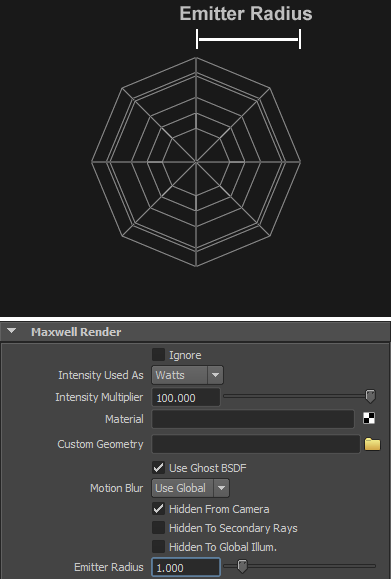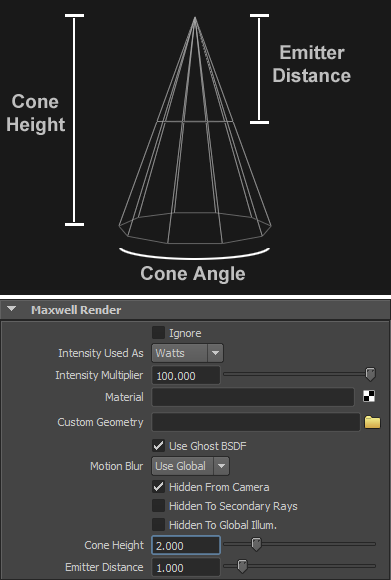Maya - Lights
The plug-in supports 3 types of Maya lights: point, spot and area. Since Maxwell does not directly offer any kind of analytic light models, the plug-in generates the appropriate geometry and emitter material for each light type:
- Point lights generate a sphere. The size of the sphere is controlled by the Emitter Radius attribute in the Maxwell Render group of the Attribute Editor.
- Spot lights generate a cone with an emitting disk inside. The height of the cone and the distance between the apex and the emitting disk can be set in the Maxwell Render rollup. The angle of the cone is taken from the built-in Maya attribute. The emitter material is applied only on the disk; a diffuse grey material is applied on the occluder cone.
- Area lights generate a square of size 2 (the same size you see in the Maya viewport). The object can be scaled to the desired size using the regular scale tool in Maya.
Geometry generated for point lights | Geometry generated for spot lights |
|---|
The generated emitter material takes its luminous intensity from the built-in intensity attribute of the Maya light. The Intensity Used As control allows you to set the unit for the intensity: watts, lumens, lux, candelas or nits. The Intensity Multiplier value can be used to scale the Maya intensity. The Intensity Scale global render option is also multiplied into the final intensity value.
The Use Ghost BSDF toggle controls the creation of a "ghost BSDF" component in the generated emitter material. When this is off, the material contains a single layer with only an emitter component inside. When the option is enabled, a fully transparent BSDF is added, so that the light geometry is not visible in the render.
It is possible to specify a custom material to be used on the emitter through the Material control. In this case, the intensity settings are ignored, and the specified material is used as-is. You can also provide custom geometry for the emitter in the form of a MXS file, skipping the automatic mesh creation. The specified MXS will be referenced into the scene and the emitter material (generated or specified) will be applied on all the objects whose names start with "emitter". If no such meshes are found, the emitter material is applied on all the objects from the MXS file. It is important to follow this naming convention when the referenced file contains both emitting and occluding geometry, as is the case for a spot light, since you do not want the occluder part to use the emitter material. The custom geometry can also be specified globally, in the render options, for each light type.
Finally, you can skip a certain light by checking the Ignore box and you can also control the usual render flags. Note that Hidden From Camera is on by default for lights. If a light is used to provide the sun direction for the physical sky or sky dome, it is automatically ignored by the exporter.

